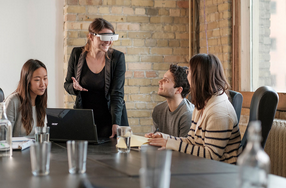By Anca Gagiuc on February 15, 2018 in Technology
More than 250 million people lack the gift of sight. While for the most of us even imagin ing what it is like to live in complete darkness is impossible, some have found a way to make a commitment that’s truly amazing—to end vision loss by 2020. Luckily, we live in the era of wearable technology.
ing what it is like to live in complete darkness is impossible, some have found a way to make a commitment that’s truly amazing—to end vision loss by 2020. Luckily, we live in the era of wearable technology.
eSight originates in Toronto, Canada, where one successful engineer—Conrad Lewis— with two legally blind sisters, wanted to use his skills to come up with a solution to their blindness. It took him seven years and investments of tens of millions of dollars to develop the technology and in 2013, managed to release two beta versions of the glasses that would revolutionize the world of the legally blind. In 2017, the company launched eSight 3, a much sleeker and lighter version of the headset, which also has improved battery life and image quality.
How does it work?
The gadget is equipped with two depth sensors and a high speed, high resolution camera positioned in the middle of the eSight glasses that captures whatever it is that the user is looking at in real time. It also has a powerful computer, which instantly processes the high definition video and displays it on two OLED screens in front of the user’s eyes, using specific optics. The gizmo’s proprietary algorithms enhance the video feed, which offers clarity without perceptible latency or delay. This allows the user to auto-focus between short-range vision to long-range vision.
A special feature—the patented Bioptic Tilt capability—enables users to adjust the eyewear to the precise position they choose and also maximize the outer peripheral vision, which people with low vision still have functional. The feature, combined with imperceptible short latency, keeps the user’s balance in check, thus no nausea occurs. Moreover, the Bioptic Tilt allows eSight users to be mobile while using the device.
eSight can be used to take photos and stream video and games with its Wi-Fi, Bluetooth and HDMI capabilities. In addition, the users can control color, contrast, focus, brightness and magnification (24X). the base unit has two hours of battery life, which can be extended to eight hours with the external battery unit.
Unfortunately, the gadget cannot help those that are profoundly or totally blind—they make about 15 percent of the worldwide population.
Still, the remaining 85 percent of legally blind people have a shot at a normal life. With eSight, they can enjoy aspects of life, otherwise far from their reach—see their loved ones, read and write, live an active lifestyle, engage in previously abandoned hobbies or work endeavors and even travel the world.
Price-wise, the device is not really affordable. Even though the cost has dropped from $15,000 to $9,995, it’s still a hefty price. But eSight has a plan for this scenario too—to register for a pair of these wonder glasses, one needs to discuss their eye impairment problem with one of the company’s vision advocates. They can help the customer fundraise the balance with support from different sources, including government programs, tax credits, insurance claims, grants, employer or educational contributions, and more.


